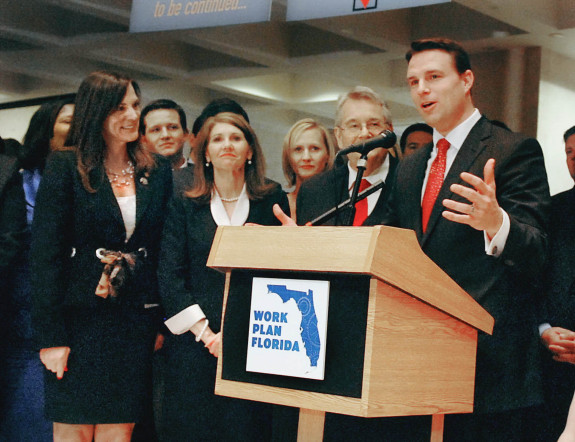
State lawmakers saw record levels of sports lobbying this past Legislative session. (Photo via MyFloridaHouse.gov)
By Ashley Lopez
Florida Center for Investigative Reporting
This past legislative session was big business for sports lobbyists, The Florida-Times Union reported this week.
According to Times-Union there were “hundreds of millions of dollars in sports incentives being considered by lawmakers, and sports teams lobbying at abnormal levels.” The Times-Union reported:
During this year’s second quarter, pro sports teams paid $150,000 in lobbying fees, according to recently filed reports. That’s up from $70,000 during the same period in 2012, and $30,000 five years ago. The second quarter is often the most lucrative for lobbyists because it includes the end of the legislative session.
In addition, lobbyists registered for “sports teams and clubs” have increased from 13 to 47 over the past five years.
“More and more teams are looking to lobbyists when they want to expand or improve their facilities,” said lobbyist Brian Ballard, president of Ballard Partners.
His firm represents the baseball teams, the Toronto Blue Jays and Houston Astros, and the speedway. Those clients collectively paid Ballard’s firm an estimated $85,000. Because the state requires firms to report only a range of lobbying fees, exact numbers are not available.
The Blue Jays, which paid an estimated $60,000 in lobbying fees, are leading the charge.
While bills carrying incentive packages for the Jaguars, Miami Dolphins, the speedway, and soccer-stadium construction in Orlando all went down in flames, lawmakers did sign off on a $50 million incentive package to help build a spring training facility in Palm Beach Gardens. It will be shared by the Blue Jays and Astros — the one sports-facility project funded by the Legislature was the one backed by the most sports-lobbying dollars.
The Miami Dolphins lobbying effort was among the most dramatic during the past session legislative session. Dolphins officials were seeking out taxpayer funds to the tune of $350 million for an upgrade of the privately-owned Sun Life Stadium in South Florida.
According to The Miami Herald, there were several last-ditch efforts to get a deal on the table, but Florida House members stopped any deal from getting passed. One of the biggest opponents of the Dolphins incentive package was Florida House Speaker Will Weatherford, which is one of the main reasons the Dolphins didn’t get their deal. The Florida Senate stood behind the plans. But the Herald reported that behind the scenes there was a full-scale lobbying effort:
Before failing, the Dolphins mounted an effort of heavy lobbying, private jet trips to Tallahassee, numerous concessions and a little procedural sleight of hand in an attempt to pull off one of the year’s most contentious legislative feats. While the Senate agreed to support the stadium deal, the team came up short in the House.
The Dolphins’ backers were still trying to attach favorable language to several different bills late Friday, a flailing effort to save the stadium upgrade in the waning hours of session.
Senators amended a massive transportation bill to add language related to sports stadiums, but the House — which has played spoiler for the Dolphins throughout the session — refused to bring the bill up for a vote.
The Dolphins were seeking up to $289 million in taxpayer support from an increase in the Miami-Dade hotel tax, from 6 to 7 percent. The proposal also offered the team a shot at up to $90 million in state sales tax rebates. The bill allowed other sports organizations to compete for state tax dollars as well.
Bogged down by strong opposition within the Miami-Dade caucus of lawmakers, the Dolphins struggled to get their proposal through the House. The failure was not for lack of trying.
The Times-Union reports that “this year’s session had a higher number of sports-related issues, but the lobbying increase likely represents a new normal rather than a single-quarter spike.”
